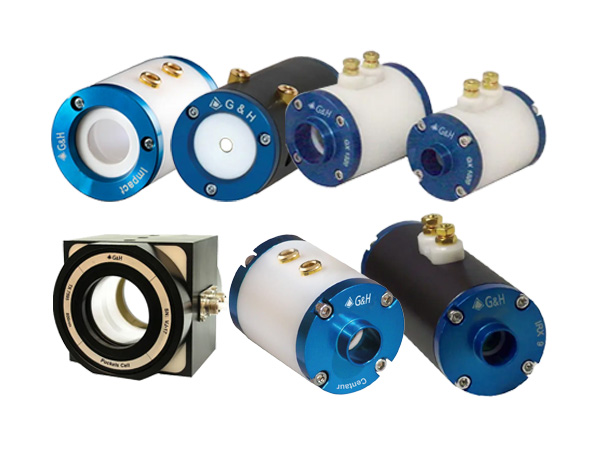
We offer the industry standard ST-QX series, economical STG-IMPACT cells, BBO-based STG-LightGate, and large-aperture STG-TX Pockels cell lines. High-speed electronic drivers properly matched to the cell produce the best results for short pulse applications.
A Pockels cell alters the polarization state of light passing through it when an applied voltage induces birefringence changes in an electro-optic crystal such as KD*P and BBO. When used in conjunction with polarizers, these cells can function as optical switches, or laser Q-switches. Frequently, Q-switches are employed in laser cavities for the purpose of shortening the output pulse, resulting in a light beam with enhanced peak intensity. In order to provide the device best suited to your purpose, we offer the industry standard ST-QX series, economical STG-IMPACT cells, BBO-based STG-LightGate, and large-aperture STG-TX Pockels cell lines. High-speed electronic drivers properly matched to the cell produce the best results for short pulse applications.
You can operate the cell with either a pull-up voltage or a pull-down voltage. Changing the polarity will only change the direction of the phase rotation. You should not, however, operate the cell with a constant applied voltage potential between the terminals, or a duty cycle greater than ~ 2%.

List of STG Series Pockels Cells
| Product Series | Wavelength | Voltage Contrast Ratio | Active Aperture | Optical Material |
| STG-Chiron BBO | 0.2 1.65µm | > 500 1 at @ 1064 nm | 3.25 mm | BBO |
| CdTe STG-IRX Mid-IR | 5-12 µm | >500 1 @ 10.6 µm | 3 - 7,4 x10 mm | CdTe |
| STG-IMPACT | 300-1100 nm | >2000 1 @ 1064 nm | 8 - 13 mm | KD*P |
| STG-QX1014A Short Path Length | 300-1100 nm | >450 1 | N/A | KD*P |
| STG-QX Series | 300-1200 nm | varies | 9.25 - 19.5 mm | KD*P |
| STG-TX Series | 300-1300 nm | varies | 19.5 - 99 mm | KD*P |
| STG-LightGate Series BBO | 300- 600 nm | >1000 1 @ 1064 nm | 2.6 - 7 mm | BBO |
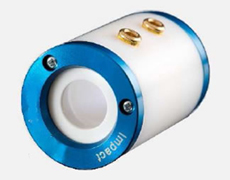
From the world leader in nonlinear materials and electro-optic devices comes the ideal Pockels cell for OEM applications, the STG-IMPACT. Once again, we set the induSRCy standard - and at an exceptional price. In general, it operates below 1kHz. The STG-IMPACT employs the finest SRCain-free, highly deuterated KD*P available. Ceramic apertures ensure robust performance in demanding applications. Ultra-high-damage threshold Sol Gel and dielectric AR coatings are offered for a variety of laser wavelengths. The standard pin-type connectors (superior for high-voltage applications) provide quick connections and simplified design and assembly. Conventional threaded connectors are available as an option. The STG-IMPACT is back-filled with dry nitrogen.
Applications:
OEM laser systems
Medical/cosmetic lasers
Versatile R&D laser platforms
Military & aerospace laser systems
FEATURES | BENEFITS |
| CCI Quality - economically priced | Exceptional value |
| Finest SRCain-free KD*P | High contrast ratio High damage threshold Low 1/2 wave voltage |
| Single pass optical transmission | >98% |
| Space efficient | Ideal for compact lasers |
| Ceramic apertures | Clean and highly damage-resistant |
| High contrast ratio | Exceptional hold-off |
| Quick electrical connectors | Efficient/reliable installation |
| Ultra-flat crystals | Excellent beam propagation |
Typical Specification
| Electro-optical @ 1064nm | ||||
| 1/4 Wave Voltage: 3.3 kV | ||||
| Transmitted Wave Front Error :<1/8 Wave | ||||
| ICR>2000:1 | ||||
| VCR>1500:1 | ||||
| Capacitance: 6 pF | ||||
| Sol Gel Damage Threshold @ 1064nm, 10ns pulse: 40J/cm2 | ||||
| Housing Dimensions | STG-IMPACT 8 | STG-IMPACT 9 | STG-IMPACT 10 | STG-IMPACT 13 |
| Aperture | 8 mm | 9.25mm | 10 mm | 13 mm |
| Length | 25 mm | 37mm | 39 mm | 45 mm |
| Diameter | 19 mm | 25.3mm | 25.35 mm | 25.35 mm |
Remark:
STG-Impact 8 standard wavelength: 1064nm & 800nm
STG-Impact 10/13 standard wavelength: 1064nm & 755nm
The 1/4 wave voltage for any of our KD*P cells, @ 800nm, will be ~2.5KV, +/- 10%
The STG-QX series sets the standard for KD*P electro-optic Q-switches. These devices provide reliable, stable performance for a diverse range of laser applications.
We offer a unique rebuild program that extends the STG-QX lifetime. All rebuilt units are upgraded with the latest product improvements and are returned with a new one-year warranty.
The standard configuration employs a broad band, high damage threshold Sol Gel AR coating for improved durability and performance. The STG-QX series is also available with index matching fluid and a choice of end caps. All units are tested for optic and electric function and are supplied with a QA inspection report.
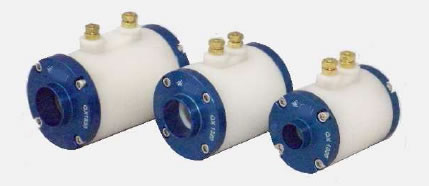 Features
Features
InduSRCy-proven performance
Dry or fluid-filled
Highest (99.9% KD*P) deuteration levels in induSRCy
Adhesive/Epoxy-free assembly
Premium UV-grade fused silica windows
Apertures from 9.25mm diameter up to 19.5mm diameter
Lowest absorption in induSRCy
High-reliability
Economical upgrade/rebuild program
Highest optical damage thresholds
Accessible technical support
Standard performance documentation
One-year limited warranty
Operation up to 10kHz (special order)
Specifications
| Typical Specification 99% KD*P | STG-QX1020 | STG-QX1320 | STG-QX1630 | STG-QX2035 |
| Physical | ||||
| Hard aperture diameter | 9.25 mm | 12.3 mm | 15.1 mm | 19.5 mm |
| Single Pass Insertion Loss | <1.4% | <1.4% | <1.8% | <2.0% |
| Voltage Contrast Ratio | ||||
| (Cross polarizers) | 5000:1 | 4000:1 | 3500:1 | 3000:1 |
| (Parallel polarizers) | 2500:1 | 1500:1 | 1800:1 | 1000:1 |
| DC Quarter wave voltage @1064nm | 3.5 kV | 3.5 kV | 3.5 kV | 3.5 kV |
| Single Pass Distortion @ 633nm | <λ/8 | <λ/8 | <λ/8 | <λ/6 |
| Electrical | ||||
| Capacitance @ 1 kHz | 5pF | 7pF | 9pF | 13pF |
| 10-90% Rise time (50Ω line) | 0.8 ns | 1.1 ns | 1.1 ns | 1.5 ns |
| Outline dimensions | ||||
| Diameter | 34.8mm | 39.7mm | 41.3mm | 46.2mm |
| Length | 55.7mm | 58.6mm | 71.0mm | 83.9mm |
The newest model in the induSRCy standard STG-QX series Pockels cell product line, the STG-QX1014A employs short path length components to reduce nonlinear self-focusing in higher peak power applications and temporal pulse broadening in femtosecond applications.
Attenuated crystal mounting minimizes acoustic artifacts when operating at repetition rates of up to 10kHz, or higher, depending upon the application. Employing internally sourced high-quality, low SRCain KD*P, the STG-QX1014A benefits from decades of electro-optic design and manufacturing experience.
The attenuation (damping) modification minimizes undesirable acoustic ringing effects, thereby permitting effective operation up to 10kHz. A variety of AR coating options are available, including our proprietary broadband 700-1000nm AR coating – ideal for minimizing round trip losses in Ti:Sapphire regenerative amplifiers.
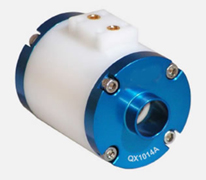
Key Features
Short path length for operation up to 10kHz
Customized AR coatings including broadband AR for Ti:Sapphire applications, choice of optional wavelengths, ceramic hard clear apertures, low VOC conSRCuction materials and high-quality KD*P
Key Benefits
Reduced B-integral for high-damage threshold
High throughput (low losses)
Applications
Ultrafast regenerative amplifiers for spectroscopy; material processing; optical parametric amplification; femtosecond lasers for life sciences (e.g. LASIK) and material processing (e.g. photolithography mask repair)
Scientific research
Specifications
Hard aperture diameter: 8mm
Intrinsic contrast ratio (ICR) @ 633 nm: >1200:1
Voltage contrast ratio (VCR) @ 633 nm: >450:1
Optical transmission @ coating wavelength: >98%
DC half-wave voltage @ 633 nm: £3.8kV
Transmitted wavefront error TWE (single pass distortion) @ 633 nm: £λ/8
Outline dimensions: Dia.34.8mm, Length 51.6mm
STG-Chiron BBO Pockels cell raises the bar for high repetition rate and high average power laser applications. The STG-Chiron BBO Pockels cell design builds on the dual crystal geometry successfully used to minimize drive voltage (~2.3 kV quarter-wave voltage @1064 nm for the STG-Chiron). BBO Pockels cells operate from approximately 0.2 to 1.65 μm and are not subject to tracking degradation. Due to the low piezoelectric coupling coefficients of BBO, the Chiron 3 functions at repetition rates up to 1 MHz. STG-Chiron Pockels cells work in regenerative amplifiers, high pulse repetition rate micro-machining lasers, and high-average power lasers for material processing and metal annealing.
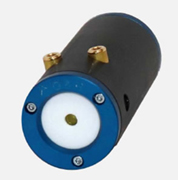
Key Features
High pulse rate operation to 1 MHz
Solid state – no index matching fluid
Low acoustic noise
Damage resistant ceramic apertures
Compact design
High-reliability
Operation at high average power
Key Benefits
Ideal for high average power systems
Low absorption leading to reduced thermal lensing/thermal depolarization
Exceptional high repetition rate performance
Excellent, accessible technical support
Applications
Military
OEM and replacement laser systems for machining, marking, via drilling; ophthalmology; Q-switching and regenerative amplifiers; research
Specifications:
Hard aperture diameter: 3.25 mm
Single pass insertion loss @ 1064 nm: < 1.5%
Intrinsic contrast ratio (ICR) @ 1064 nm: > 1000:1
Voltage contrast ratio (VCR) @ 1064 nm (parallel polarizers): > 500:1
Single pass wavefront distortion @ 1064 nm: <λ/6
LIDT1, 10 Hz @1064 nm, 10 ns, ~1 mm diameter: 10 J/cm2
Capacitance (DC): ~4 pF
DC half wave voltage @ 1064 nm: 4.3 to 4.9 kV
Temperature range exposure to simulate storage and shipping conditions:-25°C to 50°C
10-90% rise time (theoretical) into 50 Ω line:~1 ns
Duty cycle in 1 s (applied voltage time / total time):<5%
Dimensions: dia. 25.3mm length 57.7mm
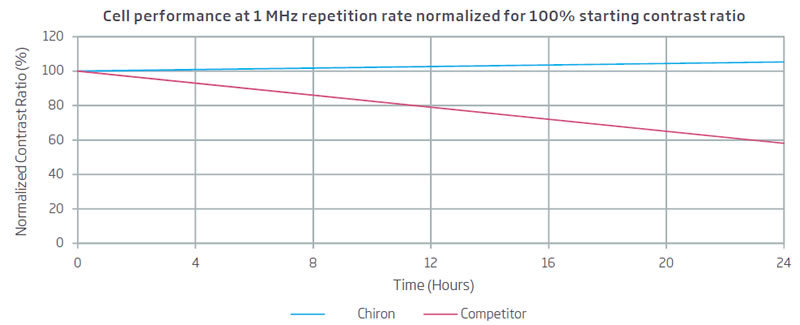
STG-TX series KD*P Pockels cells are the most advanced large aperture optical isolators commercially available and are proven performers in high power applications. We are the leading producer of Pockels cells for the development of laser induced nuclear fusion and sub-micron microlithography. Nearly 300 units are in use worldwide; more than twice the total from all other manufacturers combined. We have incorporated state-of-the-art features, such as specially modified cylindrical-ring electrode geometries for optimum aperture extinction and transmission uniformity and minimum optical path length. Series STG-TX cells also feature axially adjustable windows for sub-millimeter control of window/crystal spacing and 224 TPI differential screws for arc-second adjustment of windows parallelism or net wedge. These units typically have a lifetime of many years and can often be rebuilt for a fraction of the cost of a new unit. Each unit comes with detailed 2-page/4-photo test documentation for quality assurance. We install premium 50 ohm GHV series electrical receptacles on series STG-TX cells because of their 20 kVDC and 1 GHz mil-spec ratings (used with RG-8 A/U or RG-213/U coaxial cable). We stock GHV bulkhead receptacles as well as cable-end plugs.
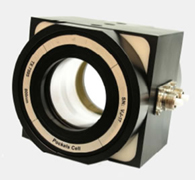
Features
Axially adjustable windows for sub-millimeter control of window/crystal spacing
224 TPI differential screws for arc-second adjustment of input/output windows parallelism
Double fill/drain ports
Individually accessible crystal faces for convenient inspection or cleaning
50 C transmission line drive configuration is standard.
Precision milled and epoxy-free
A range of apertures available
Benefits
Expanded beam allows for reduced intensity
Applications
Q-switching and optical isolators in pettawatt/terawatt lasers
Optical isolation and low frequency modulation of high power visible to NIR laser beams
| Typical Specifications | STG-TX2042 | STG-TX2650 | STG-TX3460 | STG-TX5065 | STG-TX7595 | STG-TX100D |
| PHYSICAL | ||||||
| L x H x W (mm)1 | 85x80x85 | 97x87x92 | 102x95x103 | 115x111x119 | 151x136x144 | 157x 161x169 |
| Hard aperture | 19.5 mm | 25.5 mm | 33.5 mm | 49.5 mm | 73.5 mm | 99.0 mm |
| Weight | 1.1 kg | 1.4 kg | 1.9 kg | 2.7 kg | 5.4 kg | 7.5 kg |
| Crystal deuteration2 | 95% | 95% | 95% | 95% | 95% | 95% |
| OPTICAL (1064nm) | ||||||
| Single pass insertion loss | 3.5% | 4% | 5% | 5% | 6.5% | 7% |
| Voltage contrast ratio Crossed polarizers Parallel polarizers | 8000:1 3000:1 | 8000:1 2500:1 | 6000:1 1500:1 | 3000:1 500:1 | 800:1 300:1 | 200:1 100:1 |
| Maximum residual birefringence (typically < 1% of aperture) | < 10 nm | < 12 nm | < 18 nm | < 20 nm | < 40 nm | < 80 nm |
| DC halfway voltage | 6.4 kV | 6.4 kV | 6.7 kV | 6.9 kV | 7.3 kV | 7.7 kV |
| Single pass distortion | λ/20 | λ/20 | λ/20 | λ/20 | λ/20 | λ/20 |
| ELECTRICAL | ||||||
| Capacitance @ 1 kHz | 23 pF | 27 pF | 32 pF | 56 pF | 86 pF | 115 pF |
| 10-90% risetime | 1 nsec | <2 nsec | 2 nsec | 3 nsec | 5 nsec | 7 nsec |
L=housing length along optic axis direction; W=width between electrical terminals; H=height
99% deuterated KD*P and UV-grade KDP also available in certain sizes.
Initially designed to address the Q-switched CO2 laser market at 10.6μm, the cadmium telluride - based STG-IRX Q-switch may be configured to operate from 3-12μm. Its' high electro-optic coefficient and non-hygroscopic nature makes CdTe well-suited for this purpose. Through more than 30 years of electro-optic device design experience, we provide IRX Pockels cells with application-specific AR coatings or Brewster-cut ends, in apertures ranging from 3mm-10mm. The IRX Pockels cells are able to address applications beyond the spectral range of traditional oxide Pockels cells.
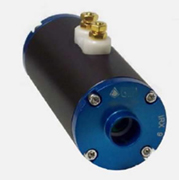
Features
High electro-optic coefficient CdTe crystal
Available with apertures ranging from 3-10 mm AR coated or Brewster-cut crystals available
Environmentally isolated EO crystal
Customized versions available
Active cooling available (patent pending)
Operation from 3 μm-12 μm up to 100 kHz
Patent pending environmental control and high power water cooled option
Non-hygroscopic material
Low optical absorption
Benefits
High contrast ratio
Operation over wide spectral range
Applications
CO2 laser Q-switching
IR pulse picking
| Typical specifications | STG-IRX3 | STG-IRX4 | STG-IRX5 | STG-IRX7 | STG-IRX9 |
| Aperture diameters 1 | 3 mm | 4 mm | 5 mm | 7 mm | 9 mm |
| Optical transmission | >98% @ 10.6 μm with 10.6 μm coatings | ||||
| Intrinsic contrast ratio (ICR) @ 10.6 μm | >500:1 | ||||
| Voltage contrast ratio (VCR) @ 10.6 μm | >500:1 | ||||
| Single pass wavefront distortion @ 10.6 μm | <λ/4 | ||||
| Spectral range of operation | Must specify wavelength or band within 5-12 μm range | ||||
| Optical transmission | >98% @ 10.6 μm with 10.6 μm coatings | ||||
| LIDT 2 | 2.3 J/cm2 , 1 mm diameter, 2.94 μm, 2 Hz, 100 ns | ||||
| DC quarter-wave voltage (±6%) @ 10.6 μm | ~4 kV | ~5 kV | ~6 kV | ~7 kV | ~9 kV |
| Capacitance (DC) | ~ 6 pF | ||||
| 10-90% rise time (theoretical) into 50 Ω line | ~0.3 ns | ||||
| Duty cycle in 1 s (applied voltage time/total time) | < 10% | ||||
| Dimensions | Dia 34.9mm, Length 92.7mm | ||||
1 Custom aperture sizes available
2 Recommended operation at 1/10 this fluence for increased longevity. LIDT will vary with wavelength and beam parameters.
RTP (Rubidium Titanyl Phosphate) is a robust electro‐optic crystal suitable for a wide variety of applications (such as Q‐Switches, Amplitude & Phase Modulators, Pulse Pickers, etc.) and operation in industrial, medical, and defence products. The crystal is transparent at most common visible and near infrared laser wavelengths. It performs well over a wide temperature range (from ‐500C to +700C) and at high repetition rates. RTP based Q‐switch devices are offered in matched pair configurations, in a temperature compensating design. When used for applications such as Q-switches and Amplitude Modulators, the crystals are mounted such that the input beam is polarized along the diagonal of the face. Our Q-switch is built using 2 RTP (Rubidium Titanyl Phosphate) elements in a temperature compensating design. The unique properties of RTP, including high electrical resistivity (~1012 Ω-cm) and a high damage threshold, result in a Q-switch with excellent properties.
Our new SRC Series IRTP Pockels Cell is the first product that brings the advantages of RTP to the EO mass market. This IRTP is a modified version of our RTP, designed specifically for industrial laser applications. It is ideal for applications that require advanced characteristics, such as non-hygroscopic, high thermal stability, and high repetition rates. This IRTP is a standard off -the- shelf solution that offers high performance EO cells at the price of standard industry Pockels Cell.

Advantages:
High Damage Threshold: No: Piezoelectric Ringing
Low Insertion Loss: Thermal: Compensating Design
Non-hygroscopic
Features:
High laser damage threshold
Fast rise-fall time and pulse width
Non-hygroscopic material
Low absorption losses
No acoustic ringing (up to at least 350kHz)
Thermal stability over a wide operational temperature range (10ºC –50ºC)
SRC Series IRTP Pockels Cell Specifications
IRTP Parameters | SRC-IRTP-6 | SRC-IRTP-8 | SRC-IRTP-10 |
Aperture | 6x6mm | 8x8mm | 10x10mm |
Capacitance | <6pf | ||
Quarter wave voltage (@1064) | 3.3KV | ||
Optical transmission | >99% | ||
ER (@1064) | ≥27dB | ||
Damage threshold | Typically, >1GW/ cm2 | ||
Alignment access | 1 axis alignment | ||
Housing Dimensions | Round: θ35mm, length 35mm (there is a 1’’ design) Square: 35mmx35mmx35mm | ||
Rise time | <1ns | ||
Thermal Stability | 10-50 Deg | ||
RTP Q-switch working at 30kHz

BBO Q-switch working at 30kHz

The graphs above show the behaviour of RTP and BBO Q switches at high repetition rates. In particular, the BBO shows Piezoelectric ringing at 30 kHz, while the RTP Q switch shows no ringing at this frequency. The BBO Q switch has a 2.5x2.5x25 mm element, while the RTP Q switch has two 6x6x7mm elements.

Minimal piezoelectric ringing
Low absorption
Broad transmission ranges from 200nm to 2000nm
Compact size
| Part Number | STC-BBO1.8 | STC-BBO2.5 | STC-BBO3.6 | STC-BBO2.8 |
| Dimensions | 25.4×39 | 25.4×39 | 25.4×39 | 20X37.5 |
| Clear Aperture | 1.8 | 2.5 | 3.6 | 2.8 |
| Crystal Size | 2*2*20 | 3*3*20 | 4*4*20 | 3X3X20 |
| Quantity of Crystals | 1 | 1 | 1 | 1 |
| Wavelength range | 410-3500nm | 410-3500nm | 410-3500nm | 410-3500nm |
| Quarter-Wave Voltage | 2400 | 3600 | 4800 | 3600 |
| Operation Wavelength | 1064nm | 1064nm | 1064nm | 1064NM |
| Electrodes | Gold-coated PIN | Gold-coated PIN | Gold-coated PIN | Gold-coated PIN |
| Insertion Loss | <2% | <2% | <2% | <2% |
| Extinction Ratio | >1000:1 | >1000:1 | >1000:1 | >1000:1 |
| Capacitance | >4 | >4 | >4 | >4 |
| LIDT@1064nm,10ns 10Hz | 500MW/cm2 | 500MW/cm2 | 500MW/cm2 | >600MW/cm2 |
| Part Number | STC-2BBO1.8 | STC-2BBO2.5 | STC-2BBO3.6 |
| Dimensions (mm) | 25.4×67 | 25.4×67 | 25.4×67 |
| Clear Aperture (mm) | 1.8 | 2.5 | 3.6 |
| Crystal Size (mm) | 2*2*20 | 3*3*20 | 4*4*20 |
| Quantity of Crystals | 2 | 2 | 2 |
| Wavelength range | 410-3500nm | 410-3500nm | 410-3500nm |
| Quarter-Wave Voltage (V) | 1200 | 1800 | 2400 |
| Operation Wavelength | 1064nm | 1064nm | 1064nm |
| Electrodes | Gold-coated PIN | Gold-coated PIN | Gold-coated PIN |
| Insertion Loss | <2% | <2% | <2% |
| Extinction Ratio | >500:1 | >500:1 | >500:1 |
| Capacitance (pF) | >4 | >4 | >4 |
| LIDT@1064nm,10ns 10Hz | 500MW/cm2 | 500MW/cm2 | 500MW/cm2 |
Our optical grade LiNbO3 crystal has good electro-optic performance, large nonlinear coefficient, good optical uniformity, stable mechanical and chemical properties, no deliquescent, low half-wave voltage, and can be applied to high repetition rate operation. It is high in extinction ratio and laser damage threshold. LN electro-optic Q-switches are widely used in Er:YAG, Ho:YAG, Tm:YAG lasers, and are suitable for low-power Q-switched output, especially in laser ranging. We offer the most compact Q-switches for our customers. Furthermore, we also can custom-design and make the Q-switches according to your specific requirements to meet your various applications.
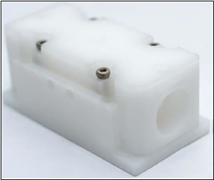
Large nonlinear optical coefficient
Large receiving angle
Small walk-off angle
Wide temperature and spectral bandwidth
High photoelectric coefficient and low dielectric constant
Non-absorbent, stable chemical and mechanical properties
| Part Number | STC-032855G1 | STC-052855G1 | STC-082855G1 | STC-092855G1 |
| Dimensions, LxWxH, mm | 55x28x24 | 55x28x24 | 55x28x24 | 55x28x24 |
| Clear Aperture, CA, mm | 2.5 | 5 | 8 | 9 |
| Crystal Size, mm | 3x3x25 | 6x6x25 | 9x9x25 | 10x10x25 |
| Quantity of Crystals | 1 | 1 | 1 | 1 |
| Wavefront Distortion | λ/8@633nm | |||
| Quarter-Wave Voltage, V | 885 | 1400 | 2400 | 2700 |
| Operation Wavelength | 1064nm | |||
| Electrodes | Cu/Cr PIN | |||
| Insertion Loss | <3% | |||
| Extinction Ratio | >500:1 (LN); >200:1 (MgO:LN) | |||
| Capacitance, pF | <5 | |||
| LIDT@1064nm,10ns 10Hz | >100MW/cm2(LN); >300MW/cm2(MgO:LN) | |||
DKDP electro-optic Q-switches (Q-switch, Pockels Cells) are widely used in high-power, narrow-pulse (<10ns) laser systems due to their unique physical properties and excellent optical quality.

The DKDP crystal is a uniaxial crystal with excellent optical quality with an extinction ratio of >2000:1 (measured using a 632 nm He-Ne laser) with a wave front distortion of 98%. The DKDP electro-optic Q-switching capacitance is small (about 3-5pF), so that the rise time is short (<0.5ns), and a narrow pulse width laser beam can be achieved during Q-switching. Compared with the widely used electro-optic crystals on the market, DKDP crystals have higher damage thresholds (>1GW/cm2) under optical conditions of 10ns pulse width, 1064 nm wavelength and repetition rate 10Hz.
Wave front distortion: low capacitance
Short rise time: ~3pf
High transmittance: >98%
High damage threshold: >1GW/cm²
No static birefringence, no photorefractive damage
Anti-reflective coated quartz window
Resistant to ambient temperature shock and excellent electro-optic performance
| Part Number | STC-DK10 | STC-DK12 | STC-DK25 | STC-DK30 | STC-DK50 |
| Dimension | D25x39mm | D25x41mm | D55X80mm | D55X80mm | NIL |
| Clear Aperture | 10mm | 12mm | 25mm | 30mm | 50mm |
| Quarter-wave Voltage | 3200V | 3200V | 6500V | 6800V | 7500V |
| Electrodes | PIN | PIN | Cu/Cr | Cu/Cr | Cu/Cr |
| Insertion Loss | <2% | <2% | <2% | <3% | <5% |
| Extinction Ratio | >2500:1 | >2500:1 | >155:1 | >1000:1 | >700:1 |
| Capacitance | <5 pF | <5 pF | <12pF | <15pF | <35pF |
| LIDT @1064nm, 10ns, 10Hz | >800MW/cm2 | >800MW/cm2 | >850MW/cm2; >1GW/cm2 @500ps | >850MW/cm2; >1GW/cm2 @500ps | >850MW/cm2; >1GW/cm2 @500ps |
We can custom-design and –make specific Q-switches such as cubic outlook, nitrogen encapsulated, lead-wire electrodes etc as follows. Please send us your detailed requirements via email or phone.

RTP (Rubidium Titanyl Phosphate) is a robust electro‐optic crystal suitable for a wide variety of applications (such as Q‐Switches, Amplitude & Phase Modulators, Pulse Pickers, etc.) and operation in induSRCial, medical, and defense products. The crystal is transparent at most common visible and near infrared laser wavelengths. It performs well over a wide temperature range (from ‐500C to +700C) and at high repetition rates. RTP based Q‐switch devices are offered in matched pair configurations, in a temperature compensating design. When used for applications such as Q-switches and Amplitude Modulators, the crystals are mounted such that the input beam is polarized along the diagonal of the face. Our Q-switch is built using 2 RTP (Rubidium Titanyl Phosphate) elements in a temperature compensating design. The unique properties of RTP, including high electrical resistivity (~1012 Ω-cm) and a high damage threshold, result in a Q-switch with excellent properties.
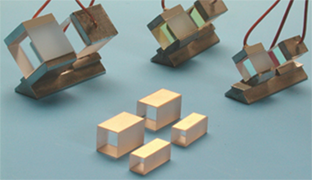
High Damage Threshold: No Piezoelectric Ringing
Low Insertion Loss: Thermal Compensating Design
Non-hygroscopic
Transmission at 1064 nm: > 98.5 %
Half Wave Voltage at 1064 nm, for 9x9x25 nm Q switch: 1.3 - 1.5 KV
Contrast Ratio: > 20 dB
Clear Aperture: From 2x2 to 15x15 mm
Acceptance Angle: > 1 degree
AR coatings: R < 0.2% at 1064 nm
Damage threshold: > 600 MW/cm2 at 1064 nm (t=10 ns)
SRC means RTP EO Q-switches, O means the crystal’s cutting orientation (X/Y/Z), CR means cross section, L means crystal length, E means extinction ratio in dB (20, 23, 25 or 30), W means wavelength.
| Part number | Crystal size (mm) | HWV (kV) | Part number | Crystal size (mm) | HWV (kV) |
| SRC-Y-020-5-20-1064 | 2x2x5 | 1.3 | SRC-Y-020-10-20-1064 | 2x2x10 | 0.66 |
| SRC-Y-030-5-20-1064 | 3x3x5 | 2.0 | SRC-Y-030-10-20-1064 | 3x3x10 | 0.99 |
| SRC-Y-040-5-20-1064 | 4x4x5 | 2.6 | SRC-Y-040-10-20-1064 | 4x4x10 | 1.3 |
| SRC-Y-050-5-20-1064 | 5x5x5 | 3.3 | SRC-Y-050-10-20-1064 | 5x5x10 | 1.7 |
| SRC-Y-060-5-20-1064 | 6x6x5 | 4.0 | SRC-Y-060-10-20-1064 | 6x6x10 | 2.0 |
| SRC-X-020-5-20-1064 | 2x2x5 | 1.6 | SRC-X-020-10-20-1064 | 2x2x10 | 0.79 |
| SRC-X-030-5-20-1064 | 3x3x5 | 2.4 | SRC-X-030-10-20-1064 | 3x3x10 | 1.2 |
| SRC-X-040-5-20-1064 | 4x4x5 | 3.2 | SRC-X-040-10-20-1064 | 4x4x10 | 1.6 |
| SRC-X-050-5-20-1064 | 5x5x5 | 4.0 | SRC-X-050-10-20-1064 | 5x5x10 | 2.0 |
| SRC-X-060-5-20-1064 | 6x6x5 | 4.8 | SRC-X-060-10-20-1064 | 6x6x10 | 2.4 |
| SRC-X-070-5-20-1064 | 7x7x5 | 5.6 | SRC-X-070-10-20-1064 | 7x7x10 | 2.8 |
| SRC-X-080-5-20-1064 | 8x8x5 | 6.4 | SRC-X-080-10-20-1064 | 8x8x10 | 3.2 |
| SRC-X-090-5-20-1064 | 9x9x5 | 7.2 | SRC-X-090-10-20-1064 | 9x9x10 | 3.6 |

The graphs above show the behaviour of RTP and BBO Q switches at high repetition rates. In particular, the BBO shows Piezoelectric ringing at 30 kHz, while the RTP Q switch shows no ringing at this frequency. The BBO Q switch has a 2.5x2.5x25 mm element, while the RTP Q switch has two 6x6x7mm elements.
A leading supplier and manufacturer of a wide range of photonics products such as lasers,laser parts & machines.
Office: 10 Bukit Batok Crescent #07-02 The Spire Singapore 658079
Tel: +65 63167112
Fax: +65 63167113
Whatsapp: +65 91904616
